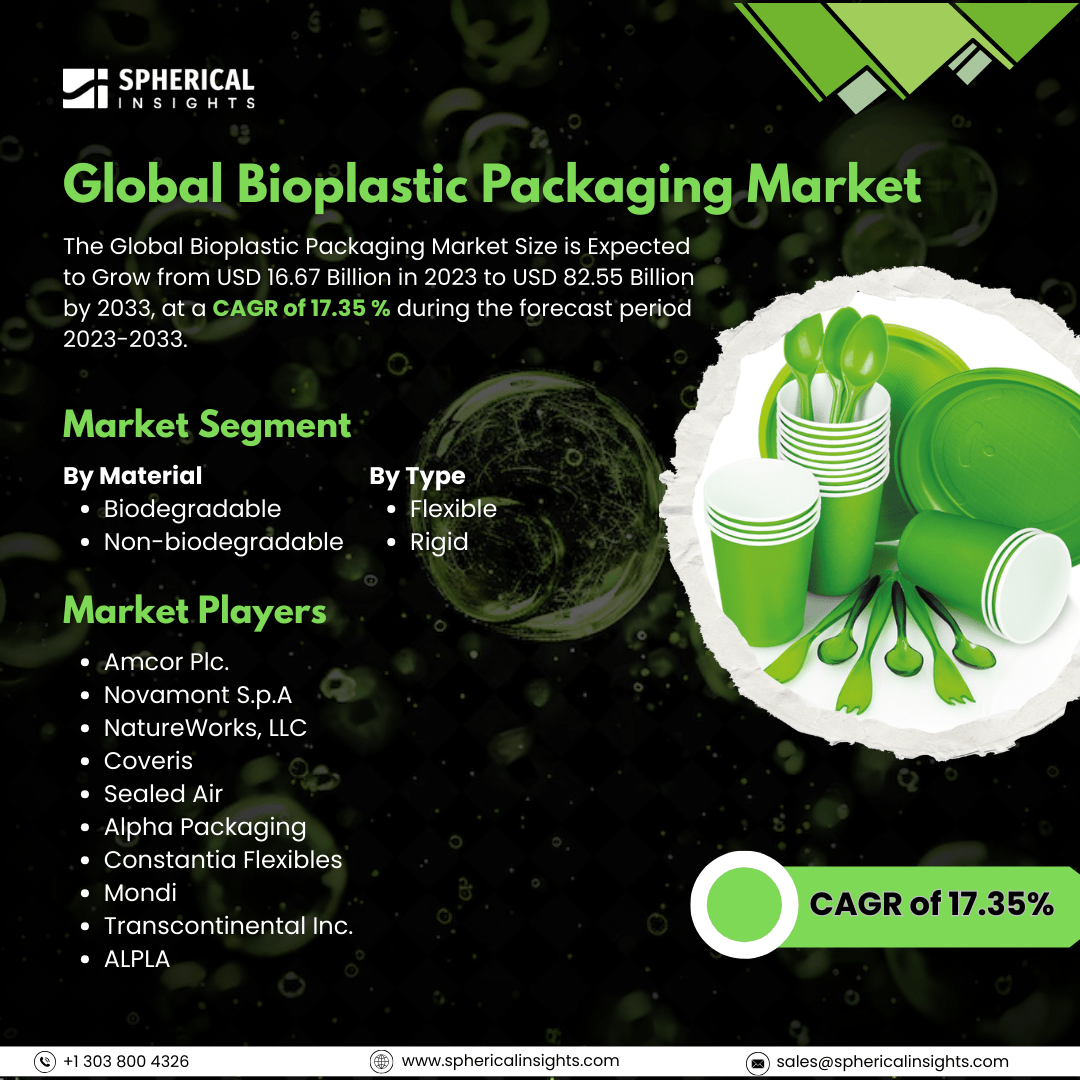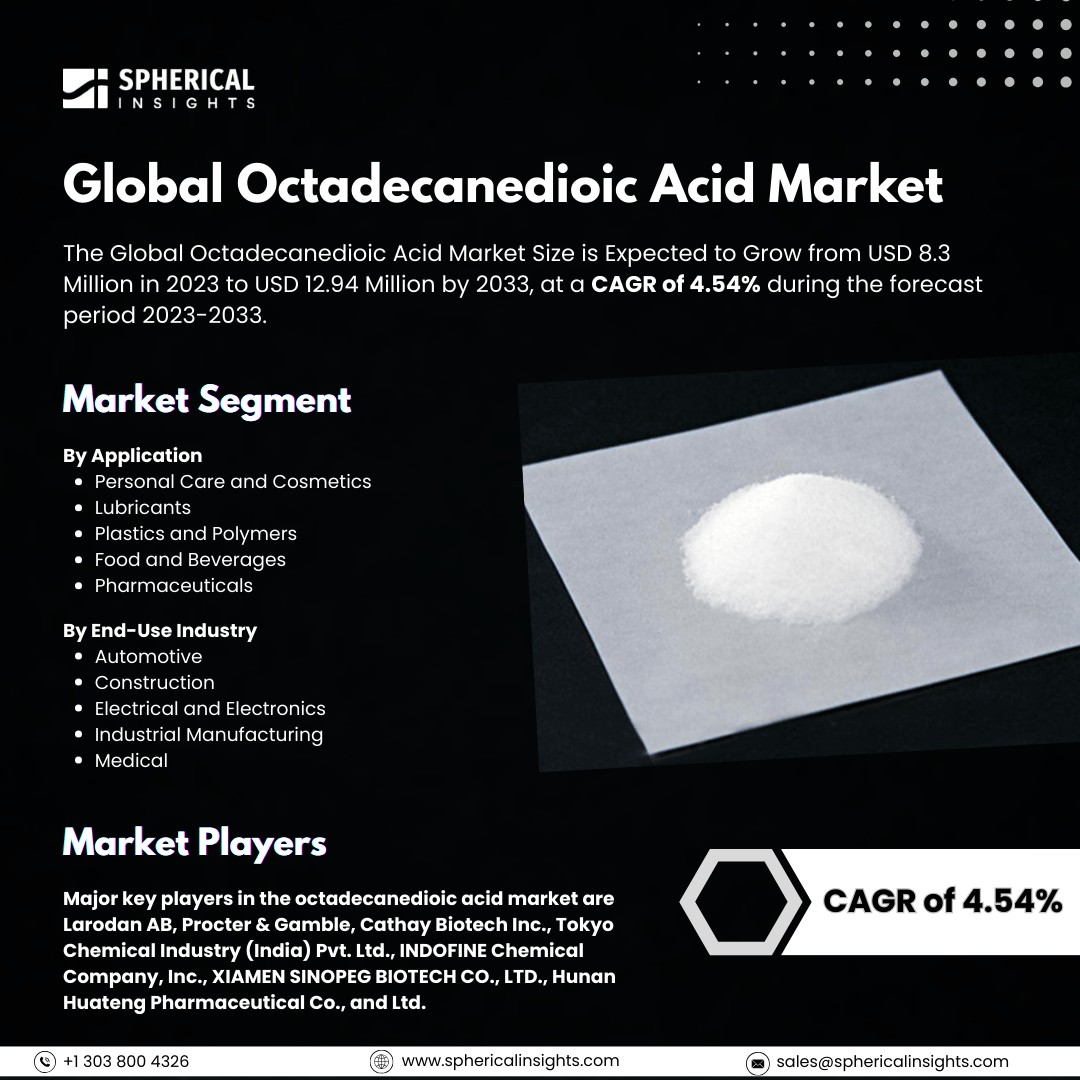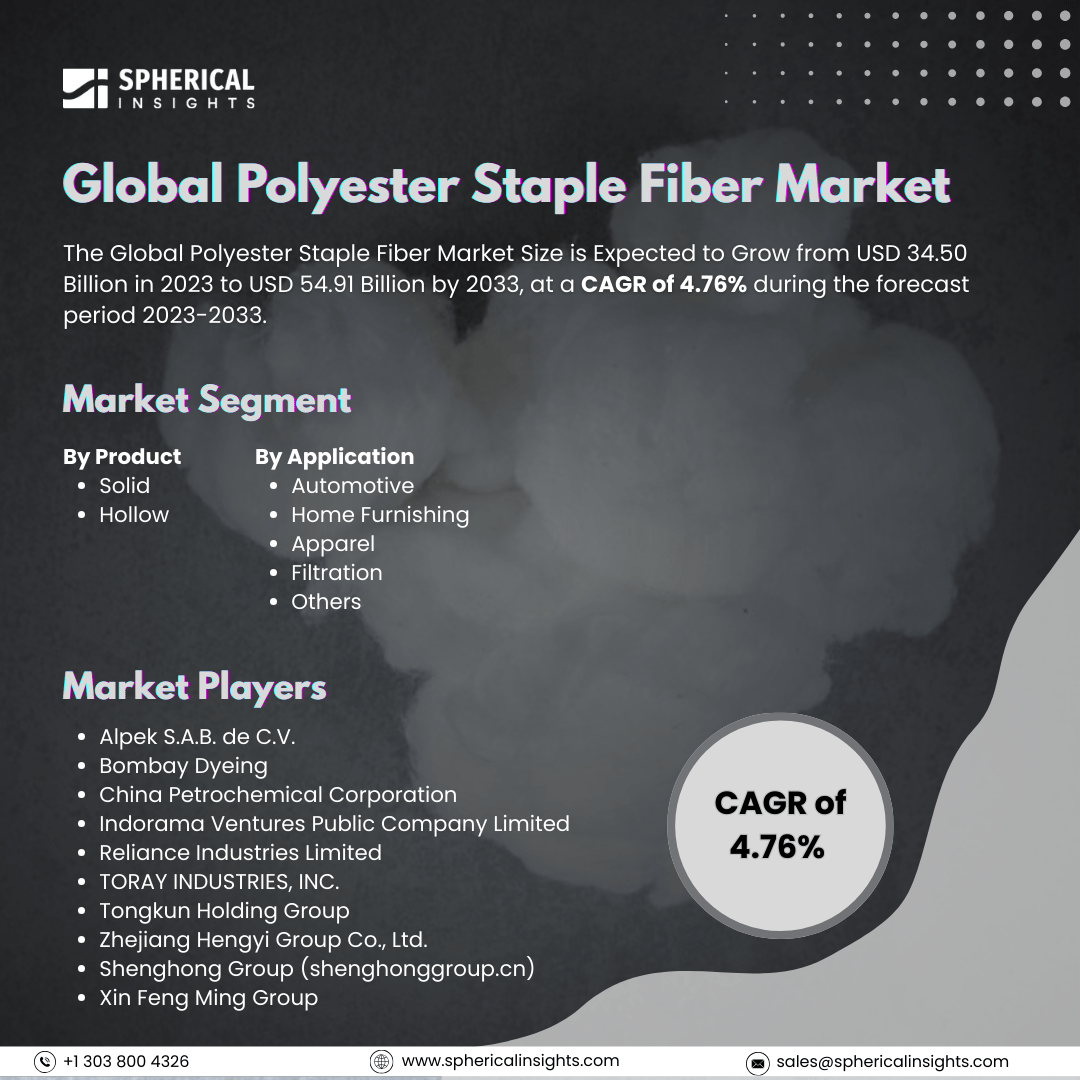Global Bioplastic Packaging Market Size to worth USD 82.55 Billion by 2033
According to a research report published by Spherical Insights & Consulting, The Global Bioplastic Packaging Market Size is Expected to Grow from USD 16.67 Billion in 2023 to USD 82.55 Billion by 2033, at a CAGR of 17.35 % during the forecast period 2023-2033.
Browse key industry insights spread across 210 pages with 110 Market data tables and figures & charts from the report on the Global Bioplastic Packaging Market Size, Share, and COVID-19 Impact Analysis, By Material (Biodegradable and Non-biodegradable), By Type (Flexible and Rigid), and By Region (North America, Europe, Asia-Pacific, Latin America, Middle East, and Africa), Analysis and Forecast 2023 – 2033.
The bioplastic packaging market involves the use of biodegradable or renewable materials to produce packaging solutions that offer environmental sustainability compared to conventional plastic packaging. Bioplastics, primarily derived from plant-based resources such as corn, sugarcane, and starch, serve as alternatives to petroleum-based plastics. These materials are gaining significant traction in various industries, including food and beverage, personal care, pharmaceuticals, and consumer goods, due to their eco-friendly properties, recyclability, and reduced carbon footprint. Key driving factors include increasing environmental concerns regarding plastic waste, growing consumer preference for sustainable products, and stringent government regulations promoting the use of biodegradable packaging materials. Moreover, the rising adoption of circular economy principles and the shift toward sustainable supply chains further bolster market growth. The demand for bioplastic packaging is also supported by innovations in material science, which have led to the development of high-performance bioplastics suitable for a variety of applications. However, challenges such as higher production costs, limited scalability, and the performance limitations of certain bioplastics in comparison to traditional plastics may hinder market growth.
The biodegradable segment accounted for the highest share in 2023 and is expected to grow at a significant CAGR during the forecast period.
Based on the material, the bioplastic packaging market is divided into biodegradable and non-biodegradable. Among these, the biodegradable segment accounted for the largest share in 2023 and is expected to grow at a significant CAGR during the forecast period. The biodegradable segment is projected to experience significant growth during the forecast period, driven by increasing environmental concerns and stringent regulations on single-use plastics.
The flexible segment accounted for the largest share in 2023 and is expected to grow at a significant CAGR during the forecast period.
Based on the type, the bioplastic packaging market is classified into flexible and rigid. Among these, the flexible segment accounted for the largest share in 2023 and is expected to grow at a significant CAGR during the forecast period. This segment's prominence is attributed to its versatility and widespread use across industries such as food and beverage, pharmaceuticals, and consumer goods. Flexible packaging's lightweight nature and efficiency contribute to reduced material usage and transportation costs, aligning with sustainability objectives.
North America is estimated to hold the greatest bioplastic packaging market share over the forecast period.
North America is estimated to hold the greatest bioplastic packaging market share over the forecast period. Large corporations and retailers are adopting bioplastic packaging to achieve their sustainability goals and respond to consumer preferences for environmentally friendly products. Initiatives such as the U.S. Plastics Pact and Canada's zero plastic waste initiatives are encouraging the transition from conventional plastics to biodegradable alternatives. Also, the existence of advanced manufacturing infrastructure and investment in biopolymer R&D allows for the creation of high-quality bioplastic materials that comply with the particular requirements of a given industry, especially food and beverage, personal care, and healthcare.
Europe is predicted to have the fastest CAGR growth in the bioplastic packaging market over the forecast period. This is based on its strong regulatory framework and commitment to the notion of a circular economy. The European Union's Green Deal and Plastics Strategy focus on managing plastic waste reduction and sustainable packaging solutions. Financial incentives for renewable material usage and targets of increasing recycled content in packaging have further supported the adoption of bioplastics. European consumers are the most environmentally aware consumers; thus, biodegradable and compostable packaging in the food and beverage industries will be a key driver for demand.
Company Profiling
Major key players in the bioplastic packaging market are Amcor Plc., Novamont S.p.A, NatureWorks, LLC., Coveris, Sealed Air, Alpha Packaging, Constantia Flexibles, Mondi, Transcontinental Inc., and ALPLA.
Key Target Audience
- Market Players
- Investors
- End-users
- Government Authorities
- Consulting And Research Firm
- Venture capitalists
- Value-Added Resellers (VARs)
Recent Developments
- In November 2024, Walki and Lactips formed a strategic partnership aimed at developing fully biodegradable and plastics-free food packaging. This collaboration focuses on using natural polymers, specifically a casein-based polymer provided by Lactips, which is derived from milk processing. The goal is to create packaging that is not only biodegradable but also recyclable within the paper stream, aligning with European regulations targeting single-use plastics.
Market Segment
This study forecasts global, regional, and country revenue from 2023 to 2033. Spherical Insights has segmented the bioplastic packaging market based on the below-mentioned segments:
Global Bioplastic Packaging Market, By Material
- Biodegradable
- Non-biodegradable
Global Bioplastic Packaging Market, By Type
Global Bioplastic Packaging Market, By Regional Analysis
- North America
- Europe
- Germany
- UK
- France
- Italy
- Spain
- Russia
- Rest of Europe
- Asia Pacific
- China
- Japan
- India
- South Korea
- Australia
- Rest of Asia Pacific
- South America
- Brazil
- Argentina
- Rest of South America
- Middle East & Africa
- UAE
- Saudi Arabia
- Qatar
- South Africa
- Rest of the Middle East & Africa



